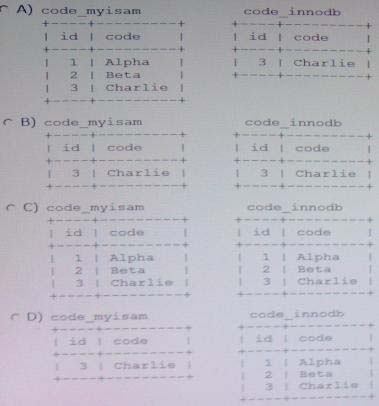Oracle 1z0-882 Exam Practice Questions (P. 4)
- Full Access (100 questions)
- One Year of Premium Access
- Access to one million comments
- Seamless ChatGPT Integration
- Ability to download PDF files
- Anki Flashcard files for revision
- No Captcha & No AdSense
- Advanced Exam Configuration
Question #16
In MYSQL 5.6 you have the table t1:
CREATE TABLE t1 (
id int unsigned NOT NULL PRIMARY key) ENGINE = InnoDB;
There are two connections to the server. They execute in this order:
Connection 1> SET TRANSACTION ISOLATION LEVEL REPEATABLE READ;
Connection 1> START TRANSACTION;
Connection 1> SELECT * FROM t1 WHERE id =1;
Connection 2> TRUNCATE TABLE t1;
What happens to the TRUNCATE TABLE command in connection 2?
CREATE TABLE t1 (
id int unsigned NOT NULL PRIMARY key) ENGINE = InnoDB;
There are two connections to the server. They execute in this order:
Connection 1> SET TRANSACTION ISOLATION LEVEL REPEATABLE READ;
Connection 1> START TRANSACTION;
Connection 1> SELECT * FROM t1 WHERE id =1;
Connection 2> TRUNCATE TABLE t1;
What happens to the TRUNCATE TABLE command in connection 2?
- AIt immediately proceeds and causes an implicit commit of the transaction in connection1.
- BIt runs concurrently with the transaction in connection 1 as each connection has its own view of the data in the t1 table.
- CIt blocks waiting for a metadata lock until the transaction in connection 1 ends.
- DIt blocks waiting for a table lock until the transaction in connection 1 ends.
Correct Answer:
C
C
send
light_mode
delete
Question #17
Your application is running slow.
Which two features provide information that help to identify problems?
Which two features provide information that help to identify problems?
- AThe MYSQL error log
- BThe slow query log
- CThe performance schema
- DThe GET DIAGNOSTICS statement
Correct Answer:
BC
BC
send
light_mode
delete
Question #18
Cormcctor/Net supports a decoupled database connection mode, where a database Connection is established only when needed.
'
Choose the three parts that are involved when working with decoupled data.
'
Choose the three parts that are involved when working with decoupled data.
- AOpenConnect.MySql, DataTTiread.MySql, CommandExecutor.MySql
- BMySqlQueryBuIld, MySqlQuerytxer. MySq I Query Results
- CDecoupODBCConn, DecoupMyScjlruiiimanrt, DecoupMySqlRetum
- DDataSet, MySqlDataAdapter, MySql Command Builder
Correct Answer:
D
Reference:
http://dev.mysql.com/doc/connector-net/en/connector-net-tutorials-data-adapter.html
D
Reference:
http://dev.mysql.com/doc/connector-net/en/connector-net-tutorials-data-adapter.html
send
light_mode
delete
Question #19
You have two test tables:
✑ Code_innodb as InnoDB engine
✑ Code_ myisam as MYISAM engine
The tables have the same structure:

The tables have one row of data:

You execute an INSERT statement on both code_myisam tables and receive duplicate key errors: mysql> INSERT INTO code_innodb VALUES (1, Alpha), (2, Beta), (3, charlie,),(4, Delta);
ERROR 1062 (23000): Duplicate entry 3 for key PRIMARY
Mysql> INSERT INTO code_myisam VALUES (1, Alpha), (2, Beta), (3, charlie),
(4, Delta);
ERROR 1062 (23000); Duplicate entry 3 for key PRIMARY
What is the expected output of the SELECT statements?

✑ Code_innodb as InnoDB engine
✑ Code_ myisam as MYISAM engine
The tables have the same structure:

The tables have one row of data:

You execute an INSERT statement on both code_myisam tables and receive duplicate key errors: mysql> INSERT INTO code_innodb VALUES (1, Alpha), (2, Beta), (3, charlie,),(4, Delta);
ERROR 1062 (23000): Duplicate entry 3 for key PRIMARY
Mysql> INSERT INTO code_myisam VALUES (1, Alpha), (2, Beta), (3, charlie),
(4, Delta);
ERROR 1062 (23000); Duplicate entry 3 for key PRIMARY
What is the expected output of the SELECT statements?

send
light_mode
delete
Question #20
Which two code samples demonstrate valid methods for working with loops?
- ADECLARE I INT DEFAULT 0; Test_loop: LOOP SET i =i +1; IF i> =5 THEN LEAVE test_loop; END IF; END LOOP test_loop;
- BDECLARE i INT DEFAULT 0; WHILE I < 5ITERATE SET i = i +1; END WHILE;
- CDECLARE i INT DEFAULT 0; WHILE i < 5 Do SET i = i + 1; END WHILE;
- DDECLARE i INT DEFAULT 0; Test _loop; LOOP SET i =i +1; IF i >=5 THEN LEAVE; END IF;
Correct Answer:
CD
CD
send
light_mode
delete
All Pages
